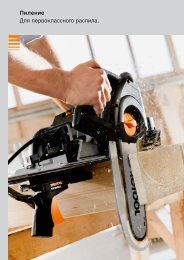Rip saw blades - CMT-SHOP
Rip saw blades - CMT-SHOP
Rip saw blades - CMT-SHOP
You also want an ePaper? Increase the reach of your titles
YUMPU automatically turns print PDFs into web optimized ePapers that Google loves.
The ABC’s of panel door construction<br />
Saw <strong>blades</strong><br />
Tools with bore<br />
& Knives<br />
In our step-by-step example of panel door construction, we used the following:<br />
- <strong>CMT</strong> Rail & Stile set (item #891.502.11)<br />
- <strong>CMT</strong> Reverse Glue Joint (item #855.501.11)<br />
- pre-cut to length stiles - 19mm thick x 57mm wide<br />
- pre-cut to length rails - 19mm thick x 57mm wide<br />
- panel - 16mm thick<br />
- scrap stock<br />
The <strong>CMT</strong> Rail & Stile set was designed ideally for the<br />
Panel<br />
construction of panel doors from 19mm thick<br />
stock, however any variation of size up to 22mm<br />
thick can be used. Remember to adjust your measurements<br />
and cutting depths according to the wood<br />
thickness you use.<br />
Rail<br />
Stile<br />
Rail<br />
Stile<br />
Stile<br />
Rail<br />
Panel<br />
ILLUSTRATION A<br />
11<br />
STOCK<br />
ILLUSTRATION B<br />
STOCK<br />
CNC Router Cutter<br />
& Chucks<br />
Router Bits<br />
& Sets<br />
ROUTER TABLE<br />
ROUTER TABLE<br />
Industrial<br />
Dowel Drills<br />
Bits for Hand<br />
Power Tools<br />
MILLING THE RAILS AND STILES<br />
First make trial cuts of the cope profile (rail) and the stick profile (stile) in scrap stock and check the accuracy of the joint. This is extremely important<br />
when working at maximum thickness (22mm). Make sure your stock is flat and cut straight with square edges. Using the <strong>CMT</strong> Stile Bit shown in illustration<br />
A, place the stock front face-down on the router table and mill the stick profile in the stile and rail pieces. To mill the rails, use the <strong>CMT</strong> Rail Bit shown<br />
in illustration A, position the rails face-down on the router table and mill the cope profile in the ends. If you are milling cope and stick profiles before cutting<br />
the rails and stiles to length, be sure to make the proper calculations before cutting the rails. The stiles are the same length as the door. The rails must<br />
be calculated by the following equation (<strong>CMT</strong> standard tenon length is 22mm):<br />
(total door width - sum of stile widths) + sum of 2 tenons = total rail length<br />
therefore, using our example measurements listed above, for a 300mm cabinet door:<br />
ILLUSTRATION C<br />
300 - 114 + 22 = 208mm<br />
FENCE<br />
GLUEING UP PANELS<br />
If the panel requires a width greater than the width of your stock, you will need<br />
to edge glue stock for the central floating panel. This is simply accomplished<br />
using the <strong>CMT</strong> Reverse Glue Joint bit. For making a two panel glue joint, place the<br />
first panel front face down on the router table and accurately centre the wood<br />
to the bit: Adjust the bit according to the thickness of the wood you are cutting<br />
by lining up the cut edge of the wood to the centre point of the bit as illustrated<br />
in illustration B and mill the cut edge of the wood. Place the second panel front<br />
face up and repeat the milling process. This assures you will have the best side<br />
of your stock as a front face. If a third panel is required, mill one cut edge of the<br />
piece as instructed above, turn the piece over and run the other edge. Assemble<br />
the reverse cut pairs together for beautiful, strong joints that match up perfectly.<br />
ROUTER TABLE<br />
Spare Parts<br />
Power Tools<br />
& Accessories<br />
Display Cabinets<br />
MILLING THE FLOATING PANEL<br />
Make trial cuts in scrap stock to create a tongue that fits snugly into the groove<br />
in the stile without forcing it. To cut your panel to size be sure to make the proper<br />
calculations, taking into account the length of the tongue. The <strong>CMT</strong> Raised<br />
Panel Bit in our example has a standard tongue length of 8mm (The New <strong>CMT</strong><br />
Raised Panel Bit profile has a 9,5mm tongue).<br />
Use the following equation:<br />
(Total door length - Sum of Stile widths) + Sum of 2 Tongues =<br />
Overall Panel Length<br />
Therefore, using our example measurements listed above for a<br />
600mm long cabinet door: (600 - 114) + 16mm = 502mm<br />
And accordingly:<br />
(Total door width - Sum of Stile widths) + Sum of 2 Tongues = Overall Panel<br />
Width.<br />
Once the panel has been cut to proper dimensions, position the panel front face<br />
side down on the router table tongue as shown in illustration C and use the <strong>CMT</strong><br />
Raised Panel Bit to mill the tongue. ATTENTION: this bit is capable of removing<br />
large amounts of stock. To safely and effectively produce the profile you want, we<br />
suggest making several shallow passes. It can be dangerous to try to mill the<br />
entire profile in a single run.<br />
ROUTER TABLE<br />
156<br />
www.cmtutensili.com




